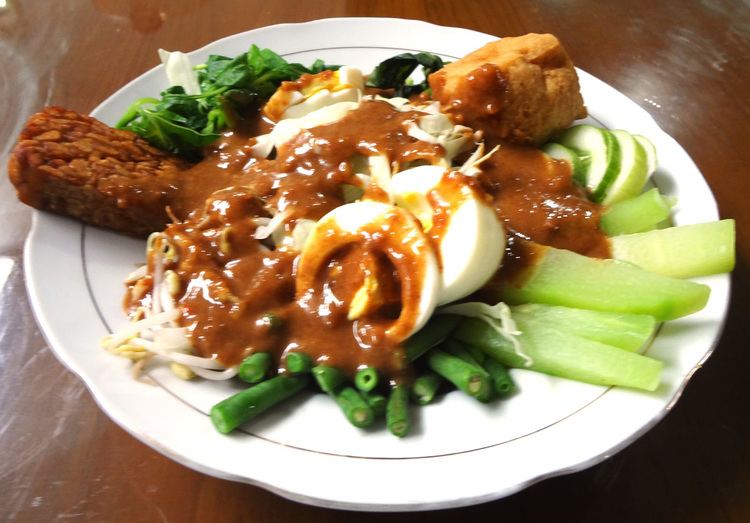Course main course | Serving temperature room temperature | |
 | ||
Similar Vegetable, Pecel, Lontong, Peanut sauce, Tofu | ||
Gado gado indonesian salad with peanut dressing norma s kitchen
Gado-gado (Indonesian or Betawi), also known as lotek (Sundanese and Javanese), is an Indonesian salad of slightly boiled, blanched or steamed vegetables and hard-boiled eggs, fried tofu and tempeh, and lontong (rice wrapped in a banana leaf), served with a peanut sauce dressing.
Contents
- Gado gado indonesian salad with peanut dressing norma s kitchen
- Gado gado vegetable salad
- Etymology
- Region
- Peanut sauce dressing
- Vegetables
- Garnishes and rice
- References

Gado gado vegetable salad
Etymology

The term gado or the verb menggado means to consume something without rice. Gado-gado in Indonesian literally means "mix-mix" since it is made of rich mixture of vegetables such as potatoes, longbeans, bean sprouts, spinach, chayote, bitter gourd, corn and cabbage, with tofu, tempeh and hard-boiled eggs, all mixed in peanut sauce dressing, sometimes also topped with krupuk and sprinkles of fried shallots. Gado-gado is different from lotek atah or karedok which uses raw vegetables. Another similar dish is the Javanese pecel.
Region

Gado-gado is widely sold in almost every part of Indonesia, with each area having its own modifications. It is thought to have originally been a Sundanese dish, as it is most prevalent in Western parts of Java (which includes Jakarta, Banten, and West Java provinces). The Javanese have their own slightly similar version of a vegetables-in-peanut-sauce dish called pecel which is more prevalent in Central and East Java. Gado-gado is widely available from hawkers' carts, stalls (warung) and restaurants and hotels in Indonesia; it is also served in Indonesian-style restaurants worldwide. Though it is customarily called a salad, the peanut sauce is a larger component of gado-gado than is usual for the dressings in Western-style salads; the vegetables should be well coated with it.
Some eating establishments use different mixtures of peanut sauce, such as adding cashew nuts for taste. In Jakarta, some eating establishment boast gado-gado as their signature dish, some of which have been in business for decades and have developed faithful clientele. Gado-Gado Boplo restaurant chain for example has been around since 1970, while Gado-Gado Bonbin in Cikini has been around since 1960.

The key to a delicious gado-gado is the sauce made of fried crushed savory peanuts, sweet palm sugar, garlic, chilies, salt, tamarind and a squeeze of lime. Formerly, gado-gado sauce was generally made to order, sometimes in front of the customers to suit their personal preference for the degree of spiciness, which corresponds to the amount of chili pepper included. However, particularly in the West, gado-gado sauce is often prepared ahead of time and in bulk. Gado-gado sauce is also available in dried form, which simply needs to be rehydrated by adding hot water.
Gado-gado sauce is not to be confused with satay sauce, which is also a peanut sauce.
Peanut sauce dressing

Most of flavours in gado-gado are acquired from the mixture of its bumbu kacang or peanut salad dressing. Gado-gado perfectly combines a slightly sweet, spicy and savory tastes. The common primary ingredients of the peanut sauce are as follows:
The traditional method of making gado-gado is to use the cobek (pestle) and ulekan or flat rounded stone. The dry ingredients are ground first, then the tamarind liquids is added to achieve the desired consistency.
Vegetables
The composition of the vegetable salad varies greatly, but usually comprises a mixture of some of the following:
Outside Indonesia, it is usual to improvise with whatever vegetables are available. All the ingredients are blanched or lightly boiled, including vegetables, potatoes and bean sprouts, except for the tempeh and tofu, which is fried, and cucumber which is sliced and served fresh. The blanched vegetables and other ingredients are mixed well with the peanut sauce.
Garnishes and rice
In Indonesia gado-gado is commonly served mixed with chopped lontong or ketupat (glutinous rice cake), or with steamed rice served separately. It is nearly always served with krupuk (crackers), e.g. tapioca crackers or emping, Indonesian style fried crackers, which are made from melinjo. A common garnish is bawang goreng a finely-chopped fried shallot sprinkles.
